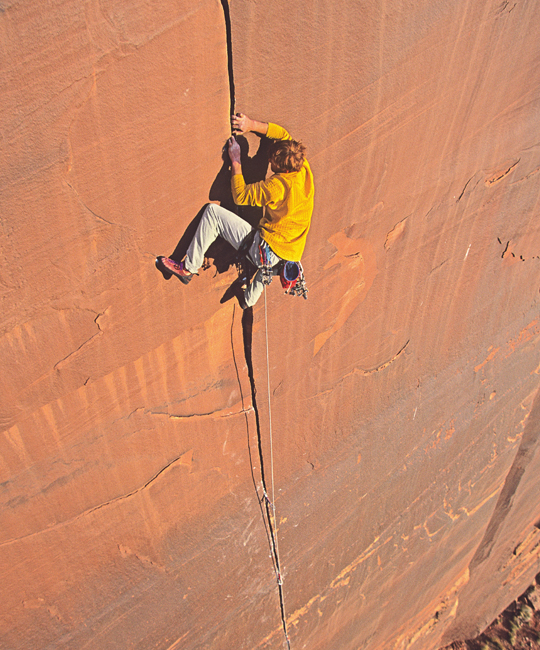This story was originally published in Alpinist 53-Spring 2016–Ed.

[Photo] Jim Thornburg
During the mid-1980s, Steve Hong was finishing his medical studies at the University of Utah, but he wasn’t yet done with his youthful antics. On weekends, he and his partners explored Indian Creek’s arid landscape of silent towers, crimson walls and grazing cattle. There, they found fissures that would eventually rank as iconic desert climbs. One was a 160-foot crack leading skyward up a smooth panel of maroon and orange varnish.
“This is THE Indian Creek classic line,” reads a 1998 paperback guidebook, Indian Creek Climbs. “Full splitter, full ropelength, full pump.” The 2013 Indian Creek: A Climbing Guide declares the route is a “Guaranteed mega-pump.”
In 1987, the crack was merely another unclimbed line. Over the course of four days, Hong attempted it with an arsenal of heavy rigid-stem Friends jangling from his harness. The 1.5-inch fissure was barely wide enough to scum a big toe inside, making it hard to stop and place gear. The repetitive movements wore him out, and he could only manage one or two attempts a day.
He lamented the limitations of his footwear, the purple- and- yellow high-top La Sportiva Mariacher rock boots. Even with their narrower profile and stable edge–a leap forward from the somewhat-shapeless Fires–the Mariachers were “basically a boot with a blunt toe,” he said, not conducive to the size of the crack. Back home in Salt Lake City, he came up with a “harebrained” idea to help his feet stay wedged.
“My friend Tom Carruthers had bigger feet than me,” Hong said. “We took an old, ratty pair of his shoes and put glue in the toes. Then I parked a truck on them to flatten the tips.” Somewhere out there is a photo of Hong wearing the pointy-tipped contraptions. He calls it “embarrassing.”
————————————————————————
On his next effort, Hong realized that while the shoes fit nicely into the crack, they were too flimsy to support any weight. He gave up on more inventions and finally freed the crack that October wearing his Mariachers, marking the end of a “campaign” in an era when more than a couple of tries on a climb remained a rarity.
Now a dermatologist in Boulder, Colorado, Hong doesn’t climb cracks anymore because “they’re too painful,” but that youthful glimmer appears in his eyes when he talks about the latest new line he’s found. At age sixty, he’s a 5.14 climber, and his forearms look like the pistons on a truck. He still remembers what he learned from all the wasted effort with the modified shoes: there will never be a shortcut for strength and technique. Hence the 1987 route’s name, Tricks Are for Kids. It’s still a hard route by modern standards and with modern shoes. No one has yet found a way to cheat through its marginal toe jams.
Meanwhile, Hong’s son, Matty, seems to have inherited his superhuman abilities. Maybe the real trick is having Steve Hong as a dad.
To see more of Jim Thornburg’s photos, follow him on Instagram.